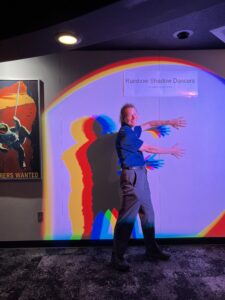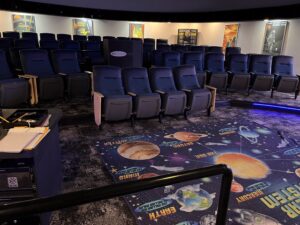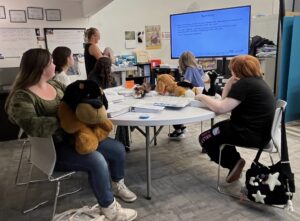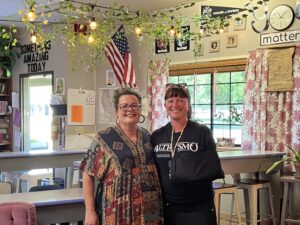From his office, Nathan Fairchild enjoys what may be the most enviable view of any California school administrator. Above him lies the universe, projected onto the dome of the Schreder Planetarium, part of the science program housed within the Shasta County Office of Education (SCOE) in Redding, California. Outside, the actual cosmos unfolds in breathtaking scenery, featuring the Cascade Range with Mt. Shasta at its heart, as well as the Shasta-Trinity National Forest and Lassen Volcanic National Park.

Nate Fairchild demonstrates the Rainbow Shadow Dancer science activity at the County Office of Education
Fairchild is the director of science programs for SCOE. His responsibilities span crafting computer programs and lesson plans for the planetarium, overseeing the Whiskeytown Environmental School for outdoor education, conducting professional development for science teachers, representing SCOE in collaborative STEM grants, and championing environmental literacy across 31 northern California counties in the California Regional Environmental Education Community (CREEC) Network.
But that’s just one facet of his portfolio. As in many rural areas of the state, local school, district, and county office administrators wear many hats. Fairchild’s other hat is director of charter school authorization for SCOE, a role that involves supporting three county-authorized charter schools and offering training and resources to the 12 charters authorized by local districts in Shasta County. With 4,640 students—or 17.5% of the county’s total enrollment—attending charter schools, his impact is significant.
Just for fun, and out of curiosity, he recently tallied the actual number of hours spent on each project. It came to 120 percent. “It definitely keeps me off the streets and out of trouble,” the 62-year-old father of two jokes.
Fairchild joined SCOE six years ago, bringing with him decades of experience in education. He started as a park ranger before transitioning to environmental education and then becoming a science teacher at a charter school in 1994. His varied teaching career included math, social studies, art, physical education, and computer science.
“The charter world is like that,” he observes, especially in places such as Shasta County—whose population of about 180,000 is smaller than the largest 25 cities in California—where authorizing districts, much like the county office of education, do not have the resources to hire full-time staff expressly focused on charter oversight. Here, unlike in large urban districts, one person may be responsible for 15 different things.
This deep understanding of rural education informs his advocacy work in Sacramento, where he pushes for policies that accommodate the unique challenges of small charter schools.
He cites the Charter Authorizer Support Initiative (CASI), created by the California Department of Education and currently implemented by CCAP and the Santa Clara County Office of Education, which offers free virtual Charter Chats and quarterly regional training sessions, as one example of their voice being heard. “That has been a boon to us,” he says gratefully.
Come One, Come All
Fairchild pulls together notes and materials from CASI trainings for local authorizers and charter leaders, who are welcome at the chats and trainings but whose schedules are even less flexible than his. Even before CASI, his attempts to gather authorizers and school leaders were not always fruitful. “I’d say, ‘Come to my charter school meetings,’ he recalls, and they’d say, ‘I can’t do that, I don’t have time to do that.’”
Now, he brings meetings to them. Nearly every month during the school year, SCOE holds an hour-long virtual meeting for authorizers and charter leaders combined. In addition to providing updates on legislative changes and discussing annual reports and renewal processes, the meetings serve a not-so-subtle purpose of fostering communication and trust between authorizers and charter schools.
Relationships between the two are not as contentious as they were when California first approved charter schools in 1992, but they remain a bit weak and guarded in some parts of the state. Because he is in contact with both authorizers and charter leaders, Fairchild found that “sometimes they were both thinking the same things, but there were fears that were getting in the way.”
There are definite signs that this approach is having a positive impact. There has been an uptick in attendance not only at SCOE’s virtual meetings, but especially at three of the monthly meetings that take place at charter schools.
For Julia Knight, founder and executive director of Northern Summit Academy (NSA) in Anderson, those are not to be missed—that is, unless something important comes up at school.

The Schreder Planetarium, located at the Shasta County Office of Education, is the centerpiece of a multi-media, hands-on science program. [Photo credit: Mark Ewing, Shasta COE]
NSA is scheduled to host one of the upcoming site meetings and, given Fairchild’s reaction at a recent visit, it will be a memorable field trip for the other authorizers and charter leaders.
“Wow! This is genius!” he proclaimed, as Knight, with equal ebullience, showed him around the newly refurbished, freshly painted building. For Knight, the compliment from Fairchild was more than just praise—it was a recognition of the effort and innovation that has gone into the school’s development.
“We’ve made this place work with what we have,” Knight says, pointing to the learning areas that had been carefully designed. “It’s about creating an environment where the students can thrive, despite the challenges we face as a small, rural charter school.”
NSA leased the 21,000 square foot former grocery store in Anderson in 2019, after SCOE approved its charter, and was in the process of renovating the space when COVID hit. In the years since, they have slowly transformed it into a vibrant hub of independent study, classrooms, and career technical education for some 200 students in transitional kindergarten through high school. Rooms are separated by moveable fabric panels that provide flexibility to change things up as necessary.
Although it was chartered as a “nonclassroom-based” school, hybrid would be a more apt description. Each student has a personalized learning plan and is required to meet weekly with their teacher of record. A parent or guardian must also attend those meetings, which can be held in person or online. Special education students are fully integrated into the curriculum by Knight and three other teachers who have special education credentials.
Many students arrive at NSA with significant academic deficits and take advantage of the school’s focus on credit recovery. Middle and high school students have the option of attending science labs and classes in math and English language arts onsite; the classes fill quickly. There is also a small library and quiet study carrells where students can access Wi-Fi.
Knight loves giving tours, and a must-see stop is the enviable makerspace, offering students an opportunity to try out more than a dozen art, science, and technology activities, including digital embroidery and quilting, laser engraving, video production, design and marketing, and robotics.
The makerspace serves multiple purposes, explained Knight. With the exception of playing games on their phones, many of these students have no outside hobbies, she said, and enrichment activities are often financially out of reach for many families.
Another intent is to spark career interests. When Knight asks high school students what they want to do or be when they graduate, most of them have no answer. “They don’t know what’s out there,” she says. “This is providing an opportunity to try things out.”

Students in the veterinary assistant program at Northern Summit Academy
NSA also offers career pathways and regional occupation programs in nursing, cosmetology, energy and power, and a veterinary assistant program with state-of-the-art equipment donated by retired veterinarians that has a 100 percent employment rate for graduates.
Given the variety of offerings, it is no surprise that every teacher and staff member at NSA has at least two job titles, including Knight, who not only runs the school but leads several pathway programs. She says the County Office of Education has been a crucial source of support, and she is effusive in describing their relationship, which started in 2014 when NSA was chartered by a local school district but contracted with SCOE for business services.
“I completely believe that that was the best decision I made when I started the charter,” said Knight. “This has been an important part of our success as a charter school.”
So, too, are the professional development opportunities, invitations to participate in grants, and just the overall interest and responsiveness shown by SCOE, evidenced by several visits from the county superintendent of schools, Mike Freeman.
“If we have a problem, even if it’s because we just don’t remember how to do something, we just call up,” Knight says. “In short, I have never had any complaints about our relationship with SCOE.”
She does have one wish, however: that SCOE board members would come visit “so that they could really see what we’re doing and what the kids are doing. Because just like our authorizer charter meetings being at other sites, it adds a whole new dimension, much deeper, much more beneficial for all of us.”
“A Completely Different Dynamic”
Fairchild’s approach to leadership is grounded in a genuine desire to be a resource, and he goes the extra mile to ensure that schools feel heard and supported, no matter the challenge.
“I just wish more of our schools knew how available we are for that,” he says. “I may not be sitting with lots of free time on the other end of the phone, but if someone calls me, we’re going to get that job done, because they need that.”
Through that commitment, he has forged strong connections with the charter school community, which was in evidence by the warm and energetic welcome he received at Chrysalis Charter School, a K-8 science-focused school with about 200 students on site and another 40 in independent study.
The middle school students were gathered outside around a large, colorful spinning wheel resembling a roulette wheel, emblazoned with the names of the school’s four “houses.” Cheers erupted as Fairchild stepped forward to give the wheel a spin, and students burst into applause, celebrating their house’s win, as Sara Lincoln, the special education director, presented Fairchild with a pin bearing the chosen house’s name.
Before Fairchild arrived, Lincoln says the county office’s connection with Chrysalis was limited. “The first half of my career here, we didn’t see them as much; I didn’t understand as much of what a resource it was,” she recalls.

Sara Lincoln (L) and Angela Rollins in Rollins’ English language arts classroom at Chrysalis Charter School
Lincoln notes that the increase in communication and support has had a tangible impact on her work at the school. “It’s just a completely different dynamic. Having that open line of communication with the county office has helped us navigate special education compliance and find resources that we didn’t even know were available.”
Fairchild demonstrated his hands-on leadership style when Lincoln expressed a pressing need for more coordinated support for special education students.
“A single point of contact at the county office of education would be my dream,” Lincoln said, her voice filled with urgency. A lot of these kids have gone to four or five schools before they come to Chrysalis, but their cumulative records often arrive weeks later, leaving her team without knowledge of their specific needs or information that could help ensure continuity of support. “If we’re so late in the game, it makes my job and our teachers’ jobs so much harder,” she said. As she finished describing the situation, Fairchild took out his phone and emailed the person at the county office who oversees special education.
Leaving No Charters Behind
Fairchild believes that every charter school in Shasta County deserves access to resources and support, regardless of whether they are directly authorized by the county office. Lane Carlson, director of Redding School of the Arts (RSA) has felt the impact of this inclusive approach.
“For single-site schools like ours, it can sometimes feel like you’re on your own, managing all those responsibilities,” Carlson says. “To have specialists and support—even when we’re not authorized by the county—has been a tremendous resource.”
Redding School of the Arts is authorized by the Columbia Elementary School District. It opened 25 years ago as a charter elementary and middle school and began growing a high school grade-by-grade four years ago. This year, it serves some 650 students in kindergarten through 12th grade, including about 75 students who learn at home but come to campus for enrichment programs. Elementary school students can participate in the Mandarin language dual immersion program.
The campus itself is as enticing as the programs it houses. In 2011, RSA moved into a new, $30 million, 77,000 square-foot LEED (Leadership in Energy and Environmental Design) platinum certified building, funded by the Redding-based McConnell Foundation. Performing arts classrooms open onto an outdoor amphitheater as does a spiral slide from the second floor.
Carlson, who has spent his career in charter schools but is relatively new to charter leadership, is as concerned with the safety of students sliding to the amphitheater as he is with ensuring that no regulations fall through the cracks. For that, he, like Knight, is grateful for the monthly meetings. “It’s been life-changing to feel like you have a team and a network of other charter leaders to reach out to for advice and support,” he says.

Performing arts classroom at Redding School of the Arts open onto the stage of an outdoor amphitheater
Driving back to the county office, Fairchild radiates joy as he reflects on the school visits. “I just feel like we have amazing charter schools and a lot of diversity,” he says. “I feel like Shasta County exemplifies what that [charter school] legislation was intended to do; let’s give some interesting, unique opportunities to families and students and encourage districts to go, ‘Oh, we can do some interesting cool things, too.’”
Fairchild also has already heard back from the person at the county office about Lincoln’s special education request: “He loves it.” Then his mind shifts to his next item of business, which is prepping for an afternoon meeting on a non-charter related issue.
“Typically, all these things mush into one day for me,” he says with a smile. “I don’t have the wonderful possibility of saying, ‘Oh, today it’ll be my planetarium day,’ because I’m going to get questions from charter schools in the middle of that day, or whatever it might be.”
He laughs. “So yeah, it’s all in a blender for me, and somehow we whip it up and bring out a nice smoothie.”
